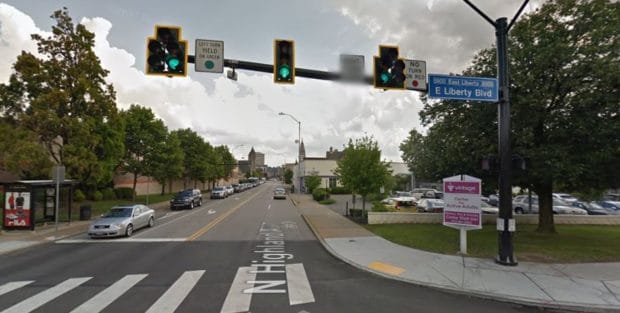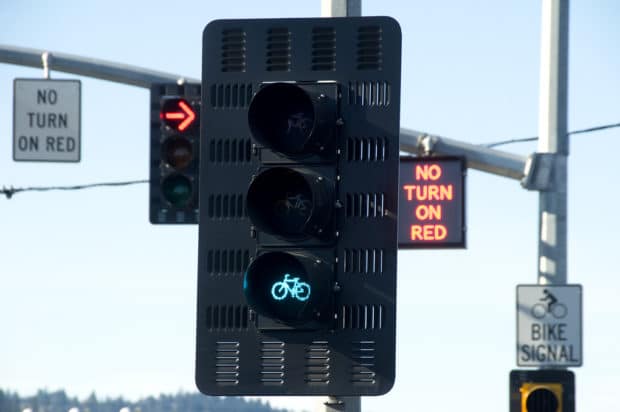Simple tools to make our streets safer for all
We’ve been paying attention to what tools other cities are using to put people first instead of cars. As you can imagine, each city is at least slightly different, but what we wanted to concentrate on were the similarities – things that we could easily emulate here in Pittsburgh with some political will, money and design expertise. We think the following street designs, designations, and public policies would move the needle in building more livable streets for all.

Image: Bike Portland Location: Portland
1. Neighborhood slow zones
20 is plenty for a reason. In fact, 20 is still arguably too fast for neighborhoods. We recommend 15mph which have their roots in school zones. If 15mph is fast enough for primary school students, it’s fast enough for all of us in our residential neighborhoods. At that speed very few crashes will happen, and if a crash did happen, very few pedestrians would die as a result. This should be the default speed of all residential neighborhood streets in the City of Pittsburgh and surrounding municipalities. Examples: NYC, Portland, Seattle

Image: Google Maps location: 5998 Perlita St New Orleans Louisiana
2. One way except bikes
Bicyclists’ movements are unique and should be regulated as such. However, if I were to compare them, they are far more like pedestrians on wheels than motorless cars. Just as pedestrians are allowed to travel in both directions on a one way street, in most cases, so should bicycle riders. This makes riding a bike an easier, more convenient choice. Pittsburgh got its first one way except bikes designation on Forbes Avenue in Oakland in 2017. Examples: DC, Chicago, Portland, Paris, Amsterdam, Copenhagen

Image: Google Maps location: 4th street Austin Texas
3. Speed humps and speed cushions
Speed humps and speed cushions slow motorists down to livable speeds. They should come standard with most neighborhood street repaving projects. In the City of Pittsburgh they only exist on two streets: Gold Way/Melwood in Polish Hill and Summerset Drive in the Summerset at Frick development. Examples: Just about every city in the world

Image: Scott Bricker Location: Amsterdam The Netherlands
4. Raised crosswalks
We need to do a much better job as a city slowing down cars. While raised crosswalks running perpendicular to a main street would also be very welcome (like the one on Living Place in Bakery Sq 2.0 development), the ones I’m really interested in are the ones that act like a threshold for cars to drive onto a slower residential street. Instead of making the pedestrian and bicycle rider have to dip down to street level to cross the street, a raised crosswalk raise cars to the pedestrian level thus forcing the driver to slow down and pay attention. Like speed humps and speed cushions, raised crosswalks provide vertical deflection for motorists so that they slow down, while making it feel as though cars are guests on this section of roadway. This type of infrastructure flips the script on who has priority at intersection. The default answer ought to be pedestrians, and this type of tool makes that so. Examples: Amsterdam, Copenhagen

Image: Chicago Bicycle Program location: Chicago
5. Protected intersections
We’re all familiar with protected bike lanes at this point. Protected intersections are really new, but they do a tremendous amount in terms of increasing awareness, visibility of bicyclists by putting them further in front of motorists, reducing conflicts, prioritizing bicyclists, and if done correctly, maintaining bikeway comfort at intersections. Examples: Chicago, Davis CA, Austin TX, Salt Lake City (more).

Image: wikicommons location: Vancouver
6. Permanent protected bike lanes
Temporary materials like plastic flex posts are a terrific conversation starter and a decent way to test designs for separated bike lanes. Now it’s time to make at least some of the temporary-style protected bike lanes permanent. The flex posts provide only a feeling of separation, but don’t do anything to keep cars and trucks from parking in the bike lanes and would do very little to keeping motor vehicles from crashing into us. Examples: Indianapolis, Amsterdam, Copenhagen, Vancouver

Image: Google Maps location: East Liberty Blvd Pittsburgh
7. No right turn on red
Right turn on red make driving more efficient but intersections far more dangerous for pedestrians and bicycle riders. In 1984, Zador et al published a report that found that, in signalized intersections where right turn on red is allowed, crashes increase by about 23%, pedestrian crashes increased ~60%, and bicyclist crashes ~100%. More: https://usa.streetsblog.org/2018/05/15/its-time-for-cities-to-rethink-right-turns-on-red/. Examples: East Liberty Blvd in Pittsburgh and lots of other places throughout the world.

Image Location: Downtown Oslo Norway
8. On-street parking removal
If our goals are to move people, on-street parking is rarely the highest and best use of space. This valuable real estate could be put to much better use by reassigning it to bus only and bike only lanes. Examples: Amsterdam, Copenhagen, and recently, Oslo Norway which is in the midst of removing most on-street parking in downtown Oslo.

Image: Reynolds Ave at Homewood Ave in Point Breeze
9. Traffic Circles
Changing the PA state vehicle code to mirror Idaho’s famous stop laws will take a revolution in new legislators who understand that biking is different than driving and ought to have its own regulations. A great short term way around this is to replace neighborhood intersections that feature stop signs to featuring traffic circles. The idea is to slow all traffic down at these intersections but not necessarily stop them completely. The myth of the scofflaw cyclist will disappear virtually overnight. The only traffic circle in Pittsburgh is in Point Breeze. While aesthetically pleasing, the lanes ought to be narrowed even further to slow down cars. Examples: Seattle, Chicago, Denver

10. Equitable Vision Zero Policy
There is no more noble a goal for our streets than to eliminate the fatalities and serious injuries that are occuring on them. An equitable approach to Vision Zero which places much greater emphasis on engineering and education than enforcement (unless automated), is the approach we would like to see taken in Pittsburgh. Examples: 34 cities nationwide including Portland, NYC, Philadelphia, San Francisco, Seattle, and D.C.

11. Textured pavement
Different pavement textures (e.g. stamped pavement, brick, and concrete bricks) slow drivers down and adds a visual indicator of lower driving speeds. Changing surfaces at intersections and along entire residential streets is a commonplace in The Netherlands and Denmark.

Image: nacto.org location: Dexter Ave Seattle
12. Floating Bus Stops
The floating serves multiple purposes. It keeps people waiting for the bus separate from through pedestrian traffic, it narrows the street making it easier for all to cross safely at intersections, it protects the bike lanes from cars using concrete, and it keeps the bus from needing to change lanes to access the bus stop. Examples: Montreal, UK 1, 2

Downtown Pittsburgh’s elimination of parking minimums has helped keep it dense and walkable
13. Eliminating parking minimums policy
Pittsburgh’s zoning code requires no parking minimum be built in Downtown, but this should be extended across the entire city. Parking minimums encourage driving, discourage dense development, make neighborhoods less walkable and bikeable, and they add to the cost of developments which inevitably get passed on to the renter thus making housing more expensive. Examples (too many to list)

Image: wikimedia commons Location: unknown
14. Bicycle specific traffic signals
We all want to see more compliance with signals. Often bicyclists will get a jump on a signal in order to get out in front of traffic in order to be seen and get a little distance at the intersection. Bicycle signals codify this behavior and make it legal, help mitigate conflicts at intersections, and raise awareness. A very low end solution is allowing bicyclists to act on an advance pedestrian signal (seen on Penn Ave Downtown for example). Specific traffic signals like the one pictured above keep bicyclists, pedestrians and private vehicles out of each other’s way at intersections by having dedicated timing for each movement. Pittsburgh got its very first bicycle specific traffic signal on Forbes Avenue in Oakland in 2017. Examples: Too many to list.
